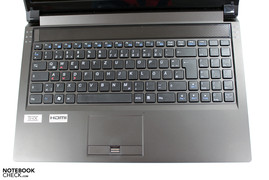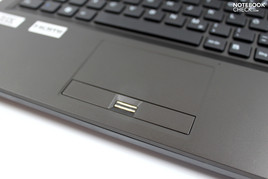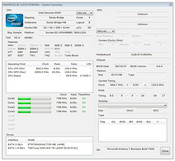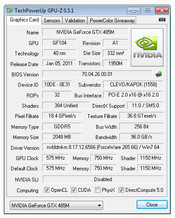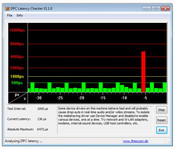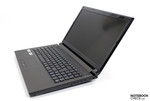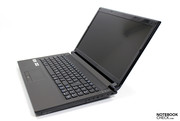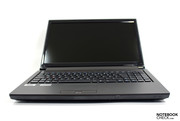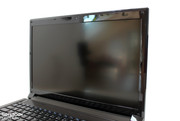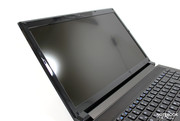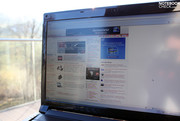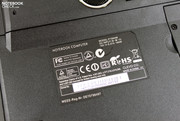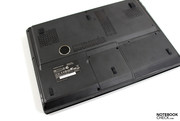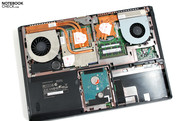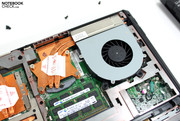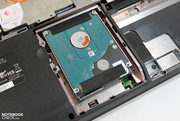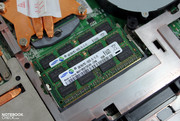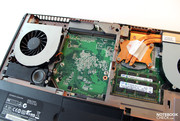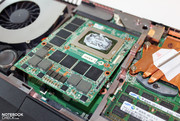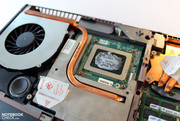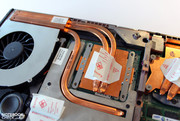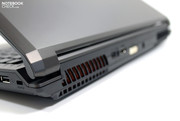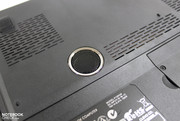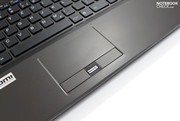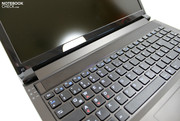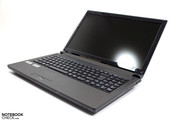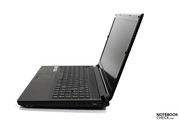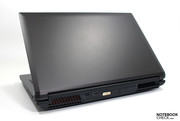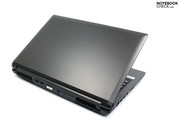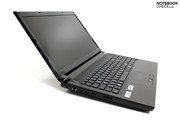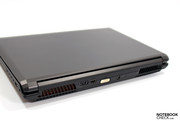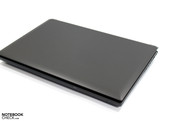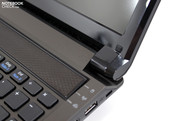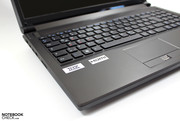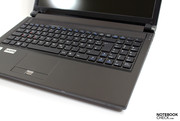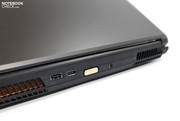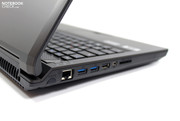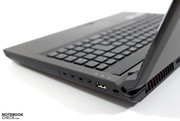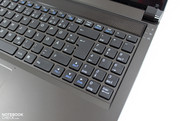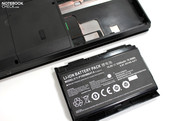Review Schenker XMG P501 Gaming-Notebook (Clevo P150HM)

Nothing's impossible – it's not necessary to have a foldable behemoth on your desk to teach even the latest desktop PC the meaning of fear. Clevo has likely designed the first good looking and absolutely mobile notebook that can be equipped with the presently strongest mobile components with the P150HM barebone.
We are talking about Nvidia's Geforce GTX 485M. It could already soar to the top of benchmarks rates in the first test and is likely the currently strongest graphics chip in a laptop. But as if that's not enough. Clevo relies on the latest Sandy Bridge technology for the CPU, which could already show an enormous performance increase in comparison to the Core i predecessors in our tests.
The German manufacturer, Schenker Notebooks, takes these highly promising barebones and configures them to an individual bundle according to the customer's wish. This ranges from a low-priced entry level solution with a GTX 460M graphics and i7-2630QM CPU up to absolute high-end solutions equipped with the aforementioned GTX 485M graphics card and Intel Sandy Bridge chip – up to the i7-2920XM CPU, which currently is the strongest mobile CPU. We have previously taken a closer look at an according configuration's performance in the GTX 485M gaming test.
We'll prove that you don't need an overpriced extreme CPU to enjoy utterly smooth frame rates in the latest games in this test. We'll put a configuration with an i7-2630QM GPU and GTX 485M through its paces. Price tag: about 1000 euros, depending on the individual configuration in detail (HDD, RAM, supplies, warranty, etc.).
Beyond that, Schenker has another highlight to offer for the P501: a matt FullHD display, that once and for all ought to wipe out the myth that ergonomic – because matt and reflection-free – screens can't keep up with glare type makeup mirrors in terms of image quality with its outstanding brightness and contrast rates.
Case
As mentioned in the start, the Schenker XMG P501 surprises with its comparatively compact case. This doesn't mean that we're dealing with something as flat as Acer's Timeline X series. But in comparison to previous 15 inch high-end gaming notebooks, the accomplished diet is recognized instantly. Even the hard facts, like weight (3.19 kilograms) or simply the dimensions (37.6 x 25.6 x 4.3 centimeters) reinforce this impression.
Another thing that we liked about the P501's case: the design language. Clevo considers all qualities and drafts an absolutely plain case with strict geometrical edges and corners and deliberately waives on playing around with colors. The notebook even has a dignified air about it among various colleagues from the business division, even in the business compartment on the train. Yes, you've read that correctly – in the train. A part of this review was written just there, thanks to the reasonable portability and the non-reflective display (as well as the outlet underneath the seat…).
After all this praise, a few words of complaint. The case is made completely of plastic, even when looking at the surfaces. Due to the silicon coating, it proves to be very resistant against fingerprints and various kinds of smudging. But it can't evoke a real high-end impression on the whole. The velvety haptic is pleasing. However, possible creaking noises are noticed here and there when you handle the notebook (base unit's edge areas, optical drive vicinity).
With exception of the area around the optical drive, the given case stability is acceptable. Especially the display lid earns itself kudos here. For example, it hardly allows forces to be passed on to the sensitive screen when selective pressure is applied. We even rate the hinges functionality as good, although you have to cope without a mechanical transport latch in a closed state.
Connectivity
Somewhat stricter demands apply to a top-notch gamer in regard to available ports. So, it should be possible to connect extensive peripherals (audio, controllers, memory solutions, etc.) without these causing obstructions. Just a glance around the case reveals a special quality. The front remains free of any ports. They are moved as far back as possible on the sides and especially unwieldy cables and plugs find their place on the rear. Thus, hardly any noteworthy restrictions turn up for righties alike lefties on the case's sides, even when ports are massively occupied.
Not only the positioning, but also the number and type of given interfaces is apt. We find a preparation for an antenna socket (not equipped in our test device), two fast USB 3.0 ports, one USB 2.0 socket Firewire and one SD cardreader on the left side edges.
On the right, the optical drive has been installed, followed by the audio ports designed as several 3.5 mm jacks (microphone, headphone, line-in, S/PDIF), another USB 2.0 port and a Kensington lock in the corner.
But that wasn't it, yet. The case's rear accommodates the power socket, a digital DVI-I interface plus a HDMI port, as well as an eSATA/USB combo. In our opinion a successful interface bundle that even let's you forgive and forget the omission of an ExpressCard slot due to the generous configuration.
Communication
The installed communication modules are the first thing that the user can configure to suit his individual needs. While wired Gigabit Ethernet belongs to the basic configuration, there are various components for the WLAN module available. You shouldn't forget an according WLAN module during the configuration process since the XMG P501 otherwise is bluntly delivered without a wireless option. Bluetooth 2.1 is also available for the wireless communication of various peripherals.
Supplies
A variety of more or less useful gadgets are basically not included. Nevertheless, Schenker bids several accessories for the P501 for a surcharge. The operating system can be freely selected, whereas you can take delight in the "nudity" of installation in an ordered, pre-installed system. That is to say, there aren't any annoying and performance-sapping tools that first have to be arduously looked for and removed.
Warranty
Schenker also leaves it up to the customer how much money he would like to invest in service and support. A 24 month bring-in service is included in the standard package. Various upgrades in regard to type and length are available for a surcharge.
Input Devices
While the available input device's qualities strongly depend on the individual preferences of every single user, there is a range of criteria that allow an objective verdict about them.
Accordingly, the keyboard's chiclet layout in the Schenker XMG P501 is pleasing. It practically grants all existing keys a sufficient size. There is also a number pad on the keyboard's right edge which can be helpful for both entering numbers and in the one or other game. Even the arrow keys, which are often affected adversely, all have received a standard key size and can be used comfortably.
Now we'll look at the typing feel of the given keys. They provide a rather short key drop with a still sufficiently clear pressure point. The soundscape while typing isn't as nice, especially when writing longer texts. The keyboard unit that extends over almost the entire width emits a clattery noise while typing. It can even be described as very annoying when the keys are hit a bit harder. Although it doesn't have a negative influence on the typing feel, this sensation does cloud the notebook's quality impression quite a bit.
Additionally, a keyboard light would be practical. However, you also have to manage without one.
Touchpad
Though not quite as important for a gamer, a touchpad is practically indispensible for a notebook. Clevo installs a multi-touch unit that can be palpated well due to its slightly submerged position in the wrist-rest area. However, the touchpad's surface shows the same silicon coating as the surrounding case. We see this as slightly problematic. The velvety haptics are actually nice, but the material is only suitable to an extent in view of gliding characteristics. Our fingers tend to rub over the surface while controlling the cursor with the touchpad. This was noticed as an unsmooth mouse cursor movement including skipping and interruptions.
Both correlating mouse keys are best used with the second hand. This solution's resistance as well as the click noise is acceptable.
The touchpad just still passes for occasional mobile use. Otherwise you should, and likely will, prefer using an external mouse.
Display
Now to the first, in our opinion, highlight of the Schenker XMG P501 gaming laptop at hand – the display. That nothing but a FullHD display (1920x1080 pixels) would come into question in view of the strong hardware configuration seems logical. But it looks different in terms of surface conditions. While probably more than 95% of computer notebooks rely on reflective screens and product managers of all brands don't tire of praising the anticipated benefits of mirrored screens, Schenker swims against the current. If desired, a screen with a matt display can be installed into the P150HM barebone. Regarding the AR coating's strength, it plays in the same league as high-quality workstations, such as the Thinkpad W701, which finds the middle ground with an almost visibly roughened display coating and polished mirror. The result: Considerably weakened, though not prevented to 100%, reflections on the display surface. In our opinion, the perfect compromise of ergonomics and image quality.
The installed display (AUO11ED) can however also score in the rates we determined for brightness and contrast. We measured an outstanding maximum of 295 cd/m2 in the display's lower center area. The brightness decreases to 212 cd/m2 in the upper corners. Consequently, the brightness distribution turns out rather meager with about 72%. Nevertheless, the naked eye doesn't perceive any shading.
| |||||||||||||||||||||||||
Brightness Distribution: 72 %
Center on Battery: 266 cd/m²
Contrast: 633:1 (Black: 0.42 cd/m²)
65.5% AdobeRGB 1998 (Argyll 3D)
94.1% sRGB (Argyll 3D)
63.7% Display P3 (Argyll 3D)
Not only the brightness, but the screen's maximum representable contrast is impressive. With high 633:1, the display can mingle in the upper league of notebook displays. Glare displays – high contrast, matt screens – low contrast? – An old wives' tale that you nevertheless hear again and again.
The reproducible color spectrum of the installed display also turns out comparatively good. sRGB is covered well. Merely the larger Adobe RGB color spectrum goes beyond the AUO display's capabilities. Thus, the majority of all displays installed in notebooks can also be excelled in this point. First professional laptops with RGB display can supply an even wider reproducible color spectrum.
Although it doesn't belong to one of the primary quality criterions for a gaming notebook, it's possible to work with the Schenker XMG P501 on the go in unfavorable ambient light conditions. The excellent brightness and the low reflection display surface look good even outdoors.
There's no unusually generous viewing angles found when examining the given viewing angles. Nevertheless, in comparison to the current multi-media midrange, the present screen is clearly superior. Even larger deviations are possible without difficulties on the horizontal plane. The displayed image remains unchanged for a long time and annoying reflections stay within limits. On the vertical plane you should remain within the nevertheless more than pleasant field to prevent image changes. Regardless of that, we didn't ever have to readjust the display's opening angle in the course of our tests to find a good image in either stationary use or mobile use.
Performance
We are facing a notebook based on Huron River, so the latest Sandy Bridge processors await us inside the Schenker XMG P501. Our first test of the Intel Quad Core Sandy Bridge range, executed with an equally constructed pre-sample of the Clevo P150HM at hand, revealed the enormous performance increase in comparison to the Montevina range's Core i processors. Detailed information about the current Intel Cougar Point problems can be found in our special. Although all the latest Sandy Bridge notebooks are affected, the manufacturing defect doesn't have an impact on the platform's performance in any way and consequently neither on the following performance tests.
Our test device was equipped with an Intel Core i7-2630QM processor. It "merely" represents the entry level of the latest quad core range of Intel processors in terms of performance reserves. However, it is on par with the previously strongest Intel i7-940XM Extreme CPU, if not superior. You are thus well-equipped for gaming purposes, where the graphics card's performance is still most important. But Schenker also has all other Sandy Bridge quad cores, up to the Intel i7-2920XM (in review here) for enthusiasts and users with especially high demands in view of the CPU's computing power.
The installed graphics card is the limits of feasibility. The likely strongest graphics card that can be found at the moment, Nvidia Geforce GTX 485M is installed in the Schenker XMG P501. The graphics card is based on the GF104 chip and thus fundamentally differs from the GTX 480M graphics card, which however also shows a completely different architecture. The GTX 485M has 384 CUDA processor cores with a clock rate of 1150 MHz. The video memory configuration is a 2 GB GDDR5. Further details about the GTX 485M can either be found in our extensive gaming test of the Nvidia Geforce GTX or also on the page with details about the graphics chip.
A comprehensive performance check of the installed CPU (i7-2630QM) can be found in our Sandy Bridge quad core review, for which the Schenker XMG P501 at hand served as the test platform.
PCMark Vantage gives insight of the entire system performance by simulating numerous application scenarios and rates them according to the available performance. In short, the present XMG P501 belongs to the strongest machines we have ever had in review with a score of 8024 points. The similarly equipped Asus G73SW achieved about 7847 points. The especially strong hard disk in our XMG P501 likely has a positive effect here.
Only more would practically be possible with a solid state drive (SSD), which can be found in our review of the latest Alienware M17x R3. It surpasses the XMG by quite a length with 12700 points. However: Schenker also equips the P501 with a fast SSD of choice if desired. Apart from the higher benchmark scores, the use of a solid state drive becomes evident for the user especially in programs' shorter loading times. The system boot is also considerably faster.
| PCMark Vantage Result | 8024 points | |
Help | ||
Let's take a look at the GTX 485M graphics card's benchmarks before moving on to the practical gaming tests. 17852 points in 3DMark 2006 (1280x1024) and P13172 in the 3DMark Vantage test, and not least P2891 in the latest 3DMark 11 qualify the installed graphics card as the currently strongest single core graphics chip. Merely the Mobility Radeon HD6970 from AMD could trouble the GTX 485M. However, according benchmarks with Sandy Bridge processors are still missing in our database. A detailed review of the HD6970 together with Intel's Montevina range can be found here.
Only systems with a dual GPU solution can hold a candle to the notebook at hand, or even beat it in certain conditions. However we would find ourselves exclusively in the heavy 17 inch sector, which can't keep up with the Schenker XMG P501 in any way in terms of mobility. The Alienware M17x R3 with a GTX 460M GPU achieves 8276 points in the 3DMark Vantage test and thus lags clearly behind. The Deviltech Fragbook DTX with an Nvidia Geforce GTX 470M and the same Sandy Bridge CPU can score 9814 points.
The older Alienware M17x with two HD 5870 graphic cards in a crossfire configuration achieves 12578 points with an i7-820QM.
| 3DMark 05 Standard | 23218 points | |
| 3DMark 06 Standard Score | 17852 points | |
| 3DMark Vantage P Result | 13172 points | |
| 3DMark 11 Performance | 2891 points | |
Help | ||
Last but not least, a short analysis of the installed mass memory. Schenker equips our test device with a conventional mass memory from Seagate (ST9750420AS) that has an enormous capacity of 750 gigabytes (one HDD!) in favor of the retail price. It is based on rotating magnetic disks, but is noticed favorably with a top rate transfer speed of more than 90 MB/s and a low access time of 15.1 milliseconds. CrystalDiskMark confirms this result, but records weaknesses in writing, especially of small data blocks (4K). Schenker alternately offers a range of other mass memories up to high-end (and expensive) SSDs upon customer's request.
Intel's Rapid Storage tool indicates port 0 for the installed hard disk. Thus, the not affected 6G port of the current chipset problems. Merely the optical drive (port 2) and the eSATA port on the case's rear (port 3) could be affected under certain circumstances, as they both use the Cougar Point chipset's 3G port. Detailed information about this can be found in this article.
In following, we will test a row of latest games with the configuration at hand in regards to their performance. A comprehensive performance check of numerous current computer games with the Nvidia Geforce GTX 485M can be found here. In opposition to the present system, the Intel i7-2920XM GPU together with the GTX 485M was used in these tests. However, the CPU's impact increasingly lessens in higher resolution levels and the achieved rates are thus comparable with the i7-2630QM CPU system tested here.
Mafia 2
The XMG P501 places itself at the top of our charts with an average of 87.3 fps in high graphic settings (1366x768, high, 16xAF) in the benchmark built into the demo version, and with 59.2 fps in ultra details (1920x1080, high, 16xAF). Surprising: The result can't be improved even with a 2920XM Extreme CPU configuration.
| Mafia 2 | |||
| Resolution | Settings | Value | |
| 1920x1080 | high, 0xAA, 16xAF | 59.2 fps | |
| 1360x768 | high, 0xAA, 16xAF | 87.3 fps | |
Colin McRae: Dirt 2
The race simulation can use the GTX 485M's resources due to DirectX 11 support. Thus, our test system delivered a smooth as silk average of 124.8 fps in high settings (1366x768, high, 2xAA). The benchmark test incorporated into the demo still delivers an excellent average of 69.7 fps with ultra graphic requirements (1920x1080, very high, 4xAA). The XMG P501 with i7-2920XM CPU only achieves 0.6 fps more, which is a bit too little to justify a surcharge of several hundred euros. A GTX 470M clearly lags behind with 53.9 fps (Deviltech Fragbook DTX) while a GTX 460M shows an even greater difference with up to 42.9 fps (Toshiba Qosmio X500).
| Battlefield: Bad Company 2 | |||
| Resolution | Settings | Value | |
| 1920x1080 | high, HBAO on, 4xAA, 8xAF | 53.5 fps | |
| 1366x768 | high, HBAO on, 1xAA, 4xAF | 100.4 fps | |
Battlefield: Bad Company 2
The popular online shooter doesn't prove to be a problem for our test device even in the highest graphics details. High settings (1366x768, high, 1xAA / 4xAF) deliver an average of 100.45fps in our benchmark test. Ultra details (1920x1080, high, 4xAA / 8xAF) still supply smooth 53.55 frames per second on average. Our test device can surpass the equally designed XMG P501 with 2920XM CPU marginally even in this test. A GTX 460M achieves up to 32fps in the same execise.
| Call of Duty: Black Ops | |||
| Resolution | Settings | Value | |
| 1920x1080 | extra, 4xAA, 8xAF | 74.2 fps | |
| 1360x768 | high, 2xAA, 4xAF | 77.5 fps | |
Call of Duty: Black Ops
Even the latest edition of the famous Call of Duty sequel isn't really a challenge for our gamer. 77.5 fps on average in high graphic details (1366x768, high, 2xAA / 4xAF), as well as 74.2 fps in ultra details (1920x1080, extra, 4xAA / 8xAF), are a guaranty for smooth gaming with maximum graphic delight.
Our configuration can even push itself in front of the composition with the 2920XM CPU, however slight it may be. A GTX 470M achieves up to 64.1 fps, a GTX 460M up to 55.7 fps.
| Colin McRae: DIRT 2 | |||
| Resolution | Settings | Value | |
| 1920x1080 | Ultra Preset, 4xAA | 69.7 fps | |
| 1360x768 | High Preset, 2xAA | 124.8 fps | |
Gaming Verdict
The Nvidia Geforce GTX 485M provides gaming entertainment at the highest level. Almost all current games can be rendered smoothly on the laptop in high detail levels in FullHD. You don't even need an Intel Extreme CPU for this. The smallest Sandy Bridge quad core chip already provides more than enough power.
| low | med. | high | ultra | |
|---|---|---|---|---|
| Colin McRae: DIRT 2 (2009) | 124.8 | 69.7 | ||
| Battlefield: Bad Company 2 (2010) | 100.4 | 53.5 | ||
| Mafia 2 (2010) | 87.3 | 59.2 | ||
| Call of Duty: Black Ops (2010) | 77.5 | 74.2 |
Emissions
System Noise
In view of the discernible emissions, the demand on a high-end gaming system, with accordingly powerful installed hardware, won't be as high as in the case of an office laptop, or especially of mobile devices. Considering this, we are fairly satisfied with the given soundscape during use without load, respectively during simple office tasks. Both fans remain completely deactivated over a longer period and merely the hard disk's noise is audible. The processor's cooling system repeatedly activates itself at a later stage and provides a somewhat more perceptible soundscape. However, it still is within an acceptable limit for an accordingly equipped gamer. Merely the repeated change between silence and activated fan gets annoying after a while. The GPU fan practically remains disabled in office mode.
When the system is put under demand by a 3D game or benchmark test (3DMark 2006), the GPU fan also starts up and increases its speed together with the CPU fan. The entire system's noise level is now at an acceptable 39 dB(A) up to a very present 45.2 dB(A) depending on the demanded performance. The latter also represents the maximum measured in the stress test. The XMG P501's noise level is also acceptable in gaming mode when a game has an accordingly captivating soundscape. You'll only want to use a headset for fading out the fan acoustically merely in especially quiet games that have high system requirements.
Noise level
| Idle |
| 32.1 / 32.1 / 35.2 dB(A) |
| HDD |
| 33 dB(A) |
| DVD |
| 38.6 / dB(A) |
| Load |
| 45.2 / 45.2 dB(A) |
 | ||
30 dB silent 40 dB(A) audible 50 dB(A) loud |
||
min: | ||
Temperature
We can't determine any striking heating on the base unit, neither on the top nor on the bottom, during operation without load. A maximum of 31.3°C in the keyboard area and 36.6°C on the bottom are within the range of a restrained office notebook.
As usual, we demand our test system with at least an hour in the stress test. Both CPU and GPU are loaded to almost 100% via Prime95 and Furmark. However, the Schenker XMG P501 remains cool even in this extreme condition and counters with a maximum temperature of only 38.2°C in the top's rear area (wrist-rest only 29.2°C) and an acceptable 45.8°C on the base unit's bottom. Considering the installed hardware, a special award goes to the Clevo P150HM barebone's cooling system.
Inside, the air is just as cool. The CPU clocks accordingly to Nvidia's specifications at almost 2.0 GHz (Prime95, all threads loaded), the graphics card with 573.8 MHz (core), respectively 1150 MHz (memory) at the start of our test.
After more than four hours of stress test, the CPU settles to merely 80°C and the GPU to a slightly higher 86°C. Both rates don't give reason for criticism. A much higher cooling capacity can be readout in particular in the CPU, which can be exhausted by using the 2920XM CPU. The CPU and GPU clock rates stay constant and even a 3DMark benchmark test, executed immediately after the stress test, doesn't show any indications that the installed components are in danger of being throttled.
(+) The maximum temperature on the upper side is 38.2 °C / 101 F, compared to the average of 40.4 °C / 105 F, ranging from 21.2 to 68.8 °C for the class Gaming.
(-) The bottom heats up to a maximum of 45.8 °C / 114 F, compared to the average of 43.3 °C / 110 F
(+) In idle usage, the average temperature for the upper side is 29.4 °C / 85 F, compared to the device average of 33.9 °C / 93 F.
(+) The palmrests and touchpad are cooler than skin temperature with a maximum of 30.2 °C / 86.4 F and are therefore cool to the touch.
(±) The average temperature of the palmrest area of similar devices was 28.8 °C / 83.8 F (-1.4 °C / -2.6 F).
Speakers
The Schenker XMG P501 has a speaker/subwoofer combination. We noticed the exceptionally good maximum rendering volume in the audio test with various music tracks. Basses could be well discerned, but the sound could be a bit smoother and more present. We would rate the sound as above average in comparison to other notebooks, but yet not as good as audio experts, such as Asus Sonic Master notebooks.
Battery Life
Our multimeter indicates a consumption of at least 26.6 W in operation without load for our test system. That is in energy savings mode with disabled wireless modules and minimum display brightness. We record about 125.1 W when the system is loaded with a game or, for example, with 3DMark 2006. Our display skyrockets up to 180.2W for a short period, only to settle at about 159W in the stress test. Nvidia's Optimus could provide yet more energy savings potential in office mode. However, it's not available for the XMG P501.
| Off / Standby | |
| Idle | |
| Load |
|
Key:
min: | |
Although the expected battery life or a gaming notebook are kept within limits, Schenker equips the XMG P501 with a voluminous 77 Wh lithium ion battery. This is enough for about 210 minutes in the lowest load assumption (BatteryReader's Reader's Test). 110 minutes are achieved in the Classic Test, whereas this doesn't stand for the worst case. The OpenGL calculation can't really put either the GPU or CPU under load, thus they don't show their maximum power appetite. A look at the possible power requirement of almost 160 watts in the stress test and the battery capacity of 77 Wh reduces the maximum possible battery life to about 30 minutes in the worst case.
If you want to watch a DVD on the system and enable the energy savings mode with adapted brightness, about two hours of runtime are possible.
Verdict
In the Schenker XMG P501 (Clevo P150HM), single high-end components experience a successful fusion to an unbeaten, compact gaming notebook. The main feature is, no doubt, Intel's Sandy Bridge / Huron River platform, which sets new standards in terms of CPU performance for the mobile field. For this, a high performance Nvidia GTX 485M graphics card is selected that also limits the benchmark scale towards the top, a potent cooling system is developed and all is packed into a plain case without much glossy paint and light effects. Flanked by a fast hard disk or even a solid state drive, there shouldn't be anything left to be desired in terms of performance reserves.
But not does everything look good only under the hood – good work has also been done around the top. In our opinion, the most important feature, aside the mentioned hardware components, is the first-rate display. In addition to the low reflection surface, it can also score with excellent rates in regard to brightness and contrast.
Are we actually talking about the perfect gaming notebook here? Not quite, regrettably. We couldn't really get comfortable with either the keyboard or the given touchpad. And anyway, a real high-end overall impression didn't turn up with the plastic surfaces and the partly insufficient form stability. The Clevo barebone has to admit clear defeat in comparison to its colleagues from Asus (G73SW) and the Alienware M17x R3 in this respect.
Nevertheless, the Schenker XMG P501 has enough power reserves and the device stays within an acceptable noise level and is even pleasantly tempered at all times. The XMG P501 presents an attractive option for the gaming orientated audience if the mentioned restrictions can be accepted. The numerous configuration options allow the perfect modifications for individual preferences and according to the budget available.








